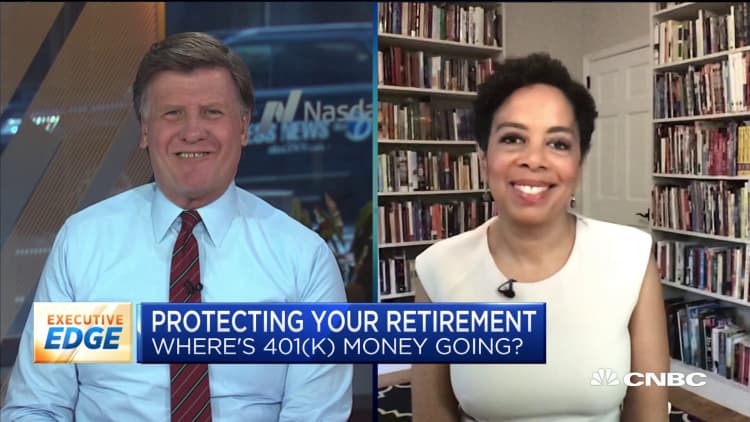Have the past few months made you reconsider how and why you spend your money? CNBC Make It would like to hear from you. Email reporter Alicia Adamczyk at alicia.adamczyk@nbcuni.com.
You've probably heard that Social Security could run out of money in the next few decades. The program's projected funding shortfall has been a political talking point for years.
Many younger Americans aren't even counting on full Social Security benefits when they retire. Only 13% of millennials (defined here as those born between 1981 and 1997) expect to rely on Social Security as their primary source of income during retirement, according to Wells Fargo's 2019 annual retirement study.
And only about 42% of millennials (defined as ages 23 to 38) and 38% of Gen Z (ages 18 to 22) are counting on Social Security to fund their retirement in any form or fashion, a January poll from the Longevity Project and Morning Consult found. That's much lower than the 64% of Gen-X and 83% of baby boomers who are counting on the program.
That cynicism may be a good thing. The coronavirus pandemic could impact the amount of Social Security money available to go around, according to new research from the Penn Wharton Budget Model, which predicts that the program's funds may now run out sooner than expected. That's because economic downturns can reduce pay, as well as the overall number of people working, which leads to lower revenues for Social Security.
How Social Security works
Social Security is primarily funded through a payroll tax. Americans who are currently working pay into a fund that is then used to provide benefits to those who are retired or disabled, as well as families in which a spouse or parent dies. Those taxes generally cover all the expenses and benefits of the program. And thanks to a Congressional change in 1983, there's actually a surplus of funds that are put away.
But starting in 2021, Social Security will need to start dipping into those reserve funds to cover benefit payments because people are living longer and millions of boomers are retiring. While the majority of Social Security benefits will still be funded through payroll taxes, the agency will use trust fund reserves to make up the difference.
Even before the recent economic downturn, experts predicted that if no changes are made, the program's reserves could run out by 2035 or 2036, just 15 years from now. At that point, Social Security would only be able to pay out about 79% of the promised benefits, according to the latest estimates.
However, the Social Security trust fund could actually run out of money four years faster than expected because of the coronavirus pandemic, the Penn Wharton Budget Model recently reported. Penn's economic model is run by a team of over a dozen economists, researchers and technicians with the aim of providing accurate, accessible and transparent economic analysis of the fiscal impact of public policy and programs.
The pandemic affects Social Security revenue in three ways, according to an analysis by Wharton researchers Sophie Shin and Yan He. First, the pandemic spurred massive job losses across the country, which reduces payroll tax revenue. Second, the pandemic-induced recession could lead to reduced earnings, lowering tax revenues even further. Third, the pandemic led to the Federal Reserve lowering interest rates, which reduces the interest received by the Social Security.

The pandemic's full effect on Social Security depends on whether the U.S. experiences a longer "U-shaped recession" where the economic output plunges and then bounces back gradually, or a quicker and more dramatic "V-shaped" recession where the country's GDP takes a sharp and rapid downturn, followed immediately by a violent upswing.
If the pandemic leads to a V-shaped recession, then Wharton's model predicts Social Security's trust fund will run out two years earlier than expected. But if the U.S. experiences a U-shaped recovery from the pandemic, which many economists and experts are now saying is likely, then the Social Security reserve will be depleted by 2032, four years earlier than expected.
Again, it's worth noting that this doesn't mean Social Security will run out of money completely. Social Security will still have funds, but it will only be able to pay out a portion of the promised benefits.
What this means for you
Many policy experts believe that federal lawmakers will implement a plan to solve the Social Security shortfall before the agency needs to start cutting benefits. But if you're a younger worker, you may want to start planning ahead.
That means saving more yourself, which can be easier said than done. If you don't already, aim to contribute the expert-recommended 15% of your income to your retirement accounts. If you're not sure what that looks like for you, an online retirement savings calculator can help give you an idea. Online investment platform Betterment has one that shows you how much money you'll have available in retirement based on your current salary and savings rate. It also shows how much Social Security would kick in at the full rate, as well as if you only receive three-fourths of your expected benefits.
The best thing you can do now to jump-start your retirement savings is to enroll in your employer's retirement plan if you're eligible and start contributing funds. If you're self-employed or working as a contractor, consider investing using a solo 401(k) or a SEP IRA.
If you have a 401(k) through work, your company may offer to match the amount of money you put in, up to a certain point. Depending on the type of program, if you put 3% of your salary into your 401(k), your employer may also contribute 3%. So it's important to make sure you're contributing at least enough to take advantage of any match your company may offer if you can.
You can also start to slowly ramp up your savings rate over time. Many 401(k) plans give investors the option to automatically increase your contribution by 1% at a time.
If your company doesn't offer a 401(k) plan, you can look into using a traditional or Roth IRA to save for retirement, depending on your income level. A taxable brokerage account may also be another way to save, although you typically need to pay taxes on any earnings you make in these accounts.
If increasing your retirement savings is not an option, you may need to consider retiring later than 65 or working part-time in retirement. "If you can keep working, do so. If you can't work full-time, work part-time. Every little bit helps," Olivia S. Mitchell, professor of insurance/risk management and business economics & public policy, and executive director of Wharton's Pension Research Council.
Check out: The best credit cards of 2020 could earn you over $1,000 in 5 years
Don't miss: 14% of Americans with retirement savings, both working and unemployed, have already tapped into those funds



